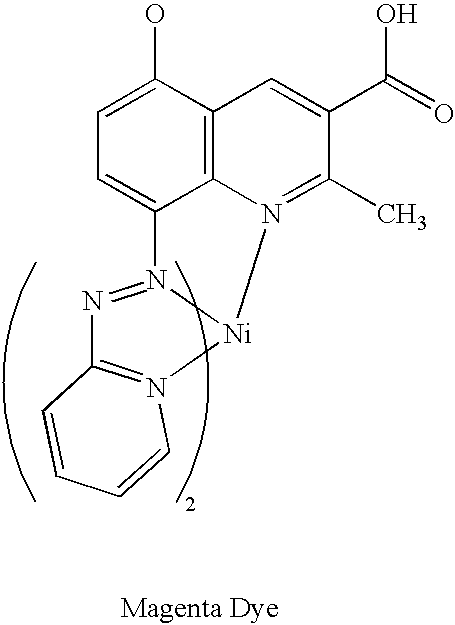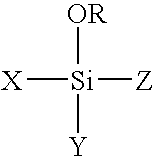Inkjet recording element
a technology of recording element and inkjet, which is applied in the direction of duplicating/marking methods, thermography, coating, etc., can solve the problems of low optical density of printed images and inability to provide inkjet images with good fade resistance, etc., and achieves fast drying time, good image quality, and color retention
- Summary
- Abstract
- Description
- Claims
- Application Information
AI Technical Summary
Benefits of technology
Problems solved by technology
Method used
Image
Examples
example 1
Dye Stability Evaluation Tests
The dye used for testing was the sodium salt of a magenta colored inkjet dye having the structure shown below. To assess dye stability on a given substrate, a measured amount of the inkjet dye and solid particulates or aqueous colloidal dispersions of solid particulates (typically about 10%-20% solids by weight) were added to a known amount of water such that the concentration of the dye was about 10−5 M and the concentration of the solid particulates was about 5%. The dispersions containing these dyes were carefully stirred and then spin coated onto a glass substrate at a speed of 1000-2000 rev / min. The spin coatings obtained were left in an ambient atmosphere with fluorescent room lighting (about 0.5 klux) kept on at all times during the test. The fade time was estimated by noting the time required for substantially complete disappearance of magenta color as observed by the naked eye. Starting from an initial optical density of about 1.0, this gene...
example 2
Element 1 (Invention)
An organosilane modified core-shell dispersion was prepared as follows: To a 200.0 g of NALCO® 2329 (40% solids), 40.0 g of a 1:1 mole ratio mixture of Silane-1 and glacial acetic acid were added very slowly while vigorously stirring the mixture. The core-shell particles in this dispersion had an R value of 52. An aqueous coating formulation was prepared using this dispersion by adding deionized lime-processed gelatin, a gelatin hardener bis(vinyl)sulfonyl methane, and surfactant Zonyl® FSN (E.I. du Pont de Nemours and Co.) to give a coating solution of 25% solids by weight and a core-shell silica / gelatin / gelatin hardener / surfactant ratio of 87.0:10.0:1.4:1.5. A polyethylene-coated paper base, which had been previously subjected to corona discharge treatment, was placed on top of a coating block heated at 40° C. A layer of the coating formulation was coated on the support using a coating blade with a spacing gap of 203 μm. The coating was then left on the coa...
example 3
Element 9 (Invention)
An organosilane modified core-shell dispersion was prepared as follows: To a 400.0 g of NALCO® TX11005 (41% solids), 60.0 g of a 1:2 mole ratio solution of Silane-2 and glacial acetic acid were added very slowly while vigorously stirring the mixture. The core-shell particles in this dispersion had an R value of 42. An aqueous coating formulation of this dispersion was prepared by combining deionized lime-processed gelatin, a gelatin hardener bis(vinyl)sulfonyl methane, and surfactant Zonyl® FSN to give a coating solution of 25% solids by weight and a core-shell silica / gelatin / gelatin hardener / surfactant ratio of 87.1:10.0:1.4:1.5. A polyethylene-coated paper base, which had been previously subjected to corona discharge treatment, was placed on top of a coating block heated at 40° C. A layer of the coating formulation was coated on the support using a coating blade with a spacing gap of 203 μm. Immediately after the coating formulation was applied, the coating...
PUM
| Property | Measurement | Unit |
|---|---|---|
| particle size diameter | aaaaa | aaaaa |
| particle size diameter | aaaaa | aaaaa |
| particle size diameter | aaaaa | aaaaa |
Abstract
Description
Claims
Application Information
 Login to View More
Login to View More - R&D
- Intellectual Property
- Life Sciences
- Materials
- Tech Scout
- Unparalleled Data Quality
- Higher Quality Content
- 60% Fewer Hallucinations
Browse by: Latest US Patents, China's latest patents, Technical Efficacy Thesaurus, Application Domain, Technology Topic, Popular Technical Reports.
© 2025 PatSnap. All rights reserved.Legal|Privacy policy|Modern Slavery Act Transparency Statement|Sitemap|About US| Contact US: help@patsnap.com


